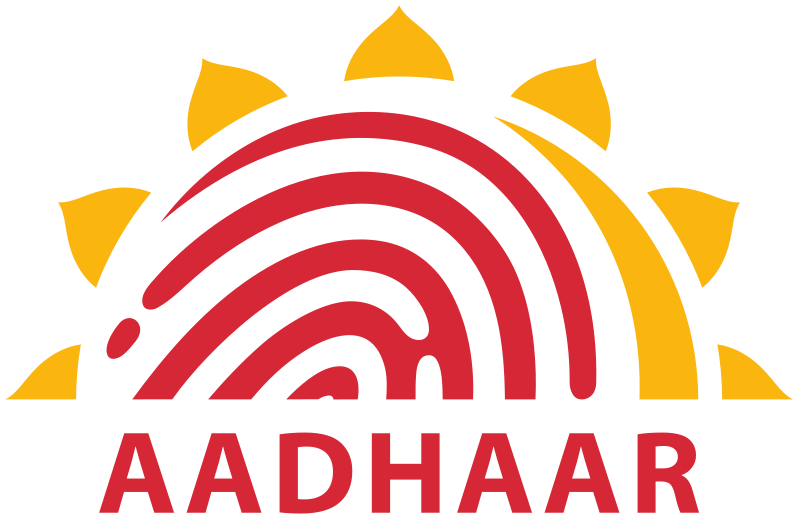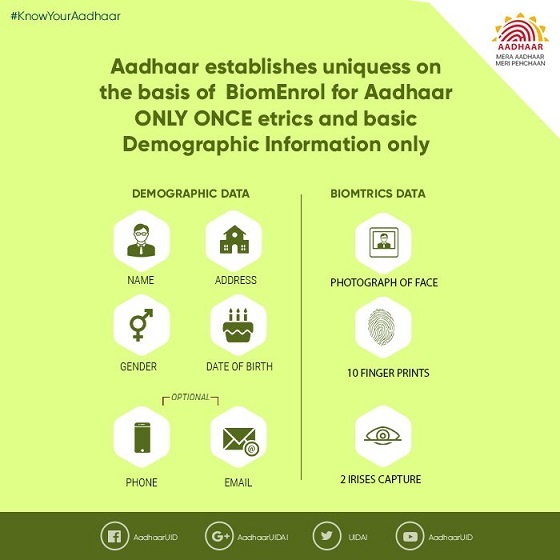The largest social project in the world

Its coverage is comparable to Twitter, but in Russia they know almost nothing about it. It does not bring net profit, but it helps to save millions of dollars. The project was launched to help 400 million people, and was implemented by a small team of 160 people, many of whom volunteered. This is all AADHAAR - an Indian biometric identification system containing more than a billion people: ten billion fingerprint patterns, two billion iris patterns, and a billion photos.
What is AADHAAR

AADHAAR (translated from Sanskrit “base”) is a unique identification number consisting of 12 digits that all residents of India can receive: both citizens and those who have been there for a long time. The first 11 digits are a random combination, which is generated by a special algorithm that prevents repeats and "beautiful" numbers. Also, AADHAAR cannot start with 0 or 1, as their thrifty Indians reserved for "just in case." The last 12 digit represents the checksum.
AADHAAR is linked to user biometric data: 10 fingerprint templates, 2 iris templates, photography. The number, confirmed by the user's biometric identification, is used in financial transactions to gain access to various public and private services. As in a good Soviet cartoon: "Mustaches, paws and tail - these are my documents."
')
Why was it necessary
India has one of the fastest growing economies in the world. But economic growth has faced a serious problem: the poverty of a huge part of the population. More than 400 million people are below the poverty line. The government spent huge funds on subsidized programs: the grocery card system that has been operating since the middle of the last century, the system of preferential education, and many other programs absorbed huge amounts of money that were spent inefficiently.
The mess was going on with the usual documents: different states had their passport samples, which in a wet and rainy Indian climate very quickly fell into disrepair. Due to the lack of imputed identification methods, people were not involved in the banking system: by 2009, only 20 percent of Indians had bank accounts.
Project history
In January 2009, the UIDAI agency was created. The agency’s task was to provide an identification number for all residents of India. And this is 1.3 billion people. The importance of the agency is evidenced by the fact that the post of its head equated to a post in the Cabinet of Ministers of India. UIDAI had to develop a number allocation scheme from scratch, create a plan for the development of the system, ensure the storage and management of all data, it was also necessary to define mechanisms and integration. It was supposed to bind a unique number to the biometric data of users.
The social significance and complexity of the project did not leave indifferent Indian programmers. Nandan Nilekani , the billionaire co-founder of Infosys Limited , one of the largest IT corporations in India, was the first to respond to an offer to tackle this fantastic task. For the sake of working on the project, he left Infosys and took the post of UIDAI Director for a salary of 1 rupee. When it became known about his appointment, hundreds of people expressed a desire to work on the project: these were both friends and colleagues of Nandan, and just people competent in this field.
In the first 16 months of operation, UIDAI received over a thousand applications for participation in the project. People threw a career in the US and Europe, took unpaid leave, switched to less paid rates to work in parallel with UIDAI. Also, people who have experience in the government sphere were invited to participate. Nandan managed to inspire and unite in a team of people from completely different worlds. And public sector workers, with the orders of the last century frozen in it, and those who grew up in the corporate Western culture. Under his leadership, people were able to overcome all contradictions, organize for the sake of a common goal and achieve their goals.
The project is developing rapidly. In July 2010, the UIDAI published a list of 15 institutions certified for the training of employees who must register users and collect biometric data. A list of 220 agencies certified to participate in the project was also published. It was estimated that to reach 40% of the population within two years, 155 training centers were needed, which should train 31019 employees. It was necessary to create 4430 centers for user registration and to prepare 22157 workplaces. Organizational development kept pace with the technical: On February 7, 2012, the online verification service AADHAAR numbers was launched, and on November 26, 2012, the transition of state programs to use AADHAAR began.
Since the project markedly complicated the cutting of state money, in certain circles it was hostile. Charges on UIDAI fell from all sides: economic groundlessness, the risk of leakage of personal data, embezzlement of public funds, the legalization of migrants from other countries, the lack of a legislative framework. In 2013, the Indian Ministry of Internal Affairs, in order to investigate the rape of a schoolgirl, demanded that the AADHAAR database be checked for an imprint found at the crime scene. UIDAI fought back: it made compromises, won one trial after another, and the Ministry of Internal Affairs was sent to the nearest lingam to increase awareness and learn math (how many of the 600 million users fall under the probability of an error of 0.015%).
In the elections in March 2014, the ruling party loses, and opponents of UIDAI come to power, openly stating the need to close the project. June 10 announced the dissolution of four government committees, including on AADHAAR. At this critical moment on July 1, the former head of UIDAI, Nandan Nilekani, met with Prime Minister Narenda Modi and Finance Minister Arun Jatley. Whether Nandan’s charisma acted, either the project’s economic results, or exotic Hindu Gods intervened, but AADHAAR not only saved, but also increased funding from $ 230 million in 2014 to $ 300 million in 2015. Finally, on March 11, 2016, a law was passed approving the work of government programs with AADHAAR.
And in April 2016, at last, the mark of one billion registered AADHAAR users was taken. The total budget at this point was only 890 million dollars.
AADHAAR usage examples
- Government programs: grocery card program, preferential education program, liquefied gas consumer subsidy program, medical assistance. Already at the first stage of the project, from July 2012 to September 2014, 1.5 million counterfeit grocery cards were voluntarily submitted. It is assumed that by 2020 the estimated savings will exceed three times the cost of UIDAI.
- The UIDAI letter on the assignment of AADHAAR is already a legal document confirming the person’s identity, except that AADHAAR is supposed to be tied to ordinary passports.
- The system of accounting of working time of civil servants: upon arrival at work, all civil servants are required to check in at biometric terminals (the last 4 digits of AADHAAR and biometric identification). And on a special site, using your number, you can see if the right person is at work or not.
- To AADHAAR attached issuing SIM-cards.
- It is supposed to use AADHAAR in the elections.
- In the financial system: linking accounts allows you to directly transfer funds to your account using the AADHAAR number, for example, using SMS. The sensational financial reform for the abolition of large bills just further spurred interest in AADHAAR.
- To protect girls on marriage ad sites, it is supposed to oblige all men to tie their profiles to AADHAAR (an exotic problem, yes).
- A cloud service is attached to AADHAAR for storing scanned documents. It is enough to send a link to the required document to any state structures.
- Work is underway to transfer the entire cadastral system of India to AADHAAR.
Conclusion
AADHAAR is a complex system that is actively developing and penetrating deeper and deeper into all spheres of Indian life. It is the largest social project, a huge identification database and an example of how modern technologies can be integrated into the daily life of a rather inert society and bring it benefit. And this project proves that people can achieve amazing results by overcoming mutual differences.
Materials on the topic:
PS Thank you so much for your attention to my article; if there are any additions, I will bring them with joy.
Source: https://habr.com/ru/post/356460/
All Articles